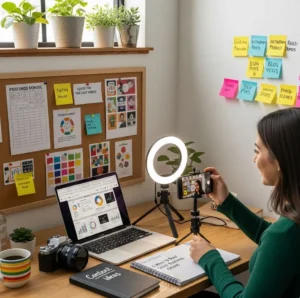
How to Market Your Small Business on a Limited Budget
Running a small business is exciting, but marketing it can feel overwhelming especially when your budget is tight. You know your product or service is great, yet reaching the right customers without spending too much can seem tricky. The good news is that effective marketing doesn’t always mean big budgets or expensive tools. With a little creativity, planning, and smart use of resources, even small businesses can make a big impact. This guide will show simple, practical strategies to get your business noticed without breaking the bank.
Marketing on a limited budget is all about working smarter, not harder. From using social media to connecting with local communities, there are many ways to promote your business without high costs. Even small actions, like sending personalized emails or posting consistent content online, can make a huge difference over time. Understanding where your audience spends time and focusing your efforts there will maximize results. By the end of this guide, you’ll have clear, actionable steps to grow your small business and reach more customers, without overspending.
Start With a Strategic Plan for Your Small Business
 Starting with a strategic plan is the first step to marketing your small business effectively, even on a limited budget. Without a clear plan, it’s easy to spend time and money on strategies that don’t bring results. Begin by understanding your business goals and the type of customers you want to reach. Knowing your audience helps you focus your efforts where they matter most. A well-thought-out plan also allows you to prioritize tasks and stay organized while promoting your business. With a clear direction, every marketing action becomes more purposeful and effective.
Starting with a strategic plan is the first step to marketing your small business effectively, even on a limited budget. Without a clear plan, it’s easy to spend time and money on strategies that don’t bring results. Begin by understanding your business goals and the type of customers you want to reach. Knowing your audience helps you focus your efforts where they matter most. A well-thought-out plan also allows you to prioritize tasks and stay organized while promoting your business. With a clear direction, every marketing action becomes more purposeful and effective.
Creating a simple marketing plan doesn’t have to be complicated. You can start by identifying which strategies will give you the most impact for the least cost. It’s important to track your progress regularly so you know what’s working and what needs adjustment. Even small businesses with limited budgets can grow steadily with a focused approach. By planning carefully, you avoid wasting resources and make every effort count toward reaching your goals.
Here are some tips to create a simple but effective marketing plan:
- Set clear and achievable marketing goals
- Identify your target audience and their preferred platforms
- Choose strategies that fit your budget and resources
- Create a schedule for posting, emailing, or sharing content
- Track results and adjust your approach as needed
Use Social Media to Connect with Customers for Your Small Business
 Social media is one of the most effective tools for marketing a small business without spending a lot of money. Platforms like Facebook, Instagram, and LinkedIn allow you to reach a wide audience and interact directly with potential customers. By sharing content regularly, you keep your business visible and build trust with your followers. Social media also helps you understand what your audience likes and what they respond to, so you can improve your marketing over time. Even a few focused posts each week can make a noticeable difference for your small business.
Social media is one of the most effective tools for marketing a small business without spending a lot of money. Platforms like Facebook, Instagram, and LinkedIn allow you to reach a wide audience and interact directly with potential customers. By sharing content regularly, you keep your business visible and build trust with your followers. Social media also helps you understand what your audience likes and what they respond to, so you can improve your marketing over time. Even a few focused posts each week can make a noticeable difference for your small business.
To get the best results, it’s important to choose the right platforms and approach them strategically. Not every platform suits every business, so focus on where your customers spend their time. Engaging with followers through comments, messages, and polls helps strengthen relationships and encourages loyalty. Visual content, like photos and short videos, often attracts more attention than plain text. By being consistent and interactive, your small business can grow its online presence without heavy costs.
Here are some tips for using social media effectively:
- Pick platforms that your target audience uses the most
- Post content that is helpful, interesting, or entertaining
- Respond to comments and messages promptly to build trust
- Use visuals like images and videos to grab attention
- Schedule posts to stay consistent without spending too much time
Create Content That Brings Value
 Creating content that brings value is a key way to attract and retain customers for your small business. Valuable content helps people see your expertise and builds trust in your brand. Instead of just promoting your products or services, focus on sharing helpful tips, how-to guides, or information that solves problems for your audience. When your content is useful, people are more likely to follow you, share your posts, and remember your business. Consistency is important; regularly posting valuable content keeps your audience engaged and encourages loyalty.
Creating content that brings value is a key way to attract and retain customers for your small business. Valuable content helps people see your expertise and builds trust in your brand. Instead of just promoting your products or services, focus on sharing helpful tips, how-to guides, or information that solves problems for your audience. When your content is useful, people are more likely to follow you, share your posts, and remember your business. Consistency is important; regularly posting valuable content keeps your audience engaged and encourages loyalty.
You don’t need a big budget to create great content. Simple tools like free graphic apps, smartphone cameras, or blog platforms can help you produce professional-looking posts. Listen to your audience to see what topics interest them most and create content around those ideas. Over time, valuable content can also improve your online visibility and bring new customers naturally. By focusing on helping your audience, your small business will grow in a way that feels meaningful and sustainable.
Here are some tips for creating valuable content:
- Share helpful tips, guides, or tutorials related to your business
- Use images, videos, or infographics to make content more engaging
- Listen to audience feedback to understand their needs
- Post consistently to stay visible and build trust
- Repurpose content across different platforms to save time
Partner With Local Communities and Brands
 Partnering with local communities and other brands is a smart way to market your small business without spending a lot. Working with local groups, events, or other businesses helps you reach new audiences who might be interested in your products or services. These partnerships build trust because people often support businesses that are active in their community. By collaborating, you can share resources, cross-promote, and create opportunities that benefit everyone involved. Even small efforts, like sponsoring a local event or co-hosting a workshop, can bring attention to your business and strengthen your reputation.
Partnering with local communities and other brands is a smart way to market your small business without spending a lot. Working with local groups, events, or other businesses helps you reach new audiences who might be interested in your products or services. These partnerships build trust because people often support businesses that are active in their community. By collaborating, you can share resources, cross-promote, and create opportunities that benefit everyone involved. Even small efforts, like sponsoring a local event or co-hosting a workshop, can bring attention to your business and strengthen your reputation.
Building strong local connections also encourages word-of-mouth marketing, which is one of the most effective and low-cost strategies. When people see your business supporting the community, they are more likely to remember and recommend you. Look for brands or organizations with similar values or audiences to make partnerships more effective. Small collaborations can grow into long-term relationships that bring ongoing benefits for your business. By being proactive and engaged locally, your small business can expand its reach without a large marketing budget.
Here are some tips for partnering locally:
- Join local business groups or networking events
- Collaborate with brands that share your audience or values
- Sponsor community events or activities to increase visibility
- Offer joint promotions or workshops with other businesses
- Support local causes to build trust and goodwill
Make the Most of Free and Low-Cost Tools for your Small Business
 Using free and low-cost tools is a smart way to market your small business without spending too much. There are many apps and platforms that help you manage social media, design graphics, schedule posts, and track results; all without a big budget. These tools save time and make it easier to stay consistent in your marketing efforts. Even a small business can look professional and organized by using the right resources. The key is to focus on tools that match your needs and make your marketing tasks simpler, not more complicated.
Using free and low-cost tools is a smart way to market your small business without spending too much. There are many apps and platforms that help you manage social media, design graphics, schedule posts, and track results; all without a big budget. These tools save time and make it easier to stay consistent in your marketing efforts. Even a small business can look professional and organized by using the right resources. The key is to focus on tools that match your needs and make your marketing tasks simpler, not more complicated.
Many free or affordable tools also help you measure what works and improve your strategies. By tracking engagement, clicks, and customer responses, you can make smarter decisions about where to invest your time and money. Experimenting with different tools can show you which ones give the best results for your business. Over time, this approach helps you grow steadily without unnecessary expenses. With the right tools, even a limited budget can go a long way in promoting your small business effectively.
Here are some tips for using tools wisely:
- Use free graphic design apps to create professional-looking visuals
- Schedule social media posts with free or low-cost platforms
- Track results with analytics tools to see what works best
- Automate repetitive tasks to save time and energy
- Focus on tools that simplify your workflow without adding extra costs
How Small Businesses Can Improve Through Customer Feedback
 Continuously improving your marketing efforts is important for the growth of your small business. Feedback from customers helps you understand what works and what needs improvement. Listening to reviews, comments, and messages gives valuable insights into your audience’s needs and preferences. By paying attention to these signals, you can make smarter marketing decisions and strengthen your relationships with customers. Small changes based on feedback can lead to better results and higher engagement over time.
Continuously improving your marketing efforts is important for the growth of your small business. Feedback from customers helps you understand what works and what needs improvement. Listening to reviews, comments, and messages gives valuable insights into your audience’s needs and preferences. By paying attention to these signals, you can make smarter marketing decisions and strengthen your relationships with customers. Small changes based on feedback can lead to better results and higher engagement over time.
Using insights and data also allows you to focus your efforts where they matter most. Track metrics such as website visits, social media engagement, or email responses to see which strategies are most effective. Experiment with different approaches and measure the results to learn what resonates with your audience. Regularly reviewing your performance makes sure that your small business continues to grow without wasting resources. By embracing feedback and insights, you can refine your marketing strategies and achieve long-term success.
Here are some tips for improving with feedback and insights:
- Ask customers for feedback through surveys or social media
- Monitor engagement on posts, emails, and website activity
- Test new strategies and compare results to previous efforts
- Adjust your marketing plan based on what works best
- Keep learning from both successes and mistakes to grow steadily
Conclusion
Marketing a small business on a limited budget doesn’t have to be stressful or complicated. By planning carefully, using social media wisely, creating valuable content, partnering locally, leveraging free tools, and learning from feedback, even small businesses can grow steadily and reach more customers. The key is to stay consistent, experiment with new ideas, and focus on strategies that truly connect with your audience. Every small effort adds up and can make a big difference over time. We’d love to hear from you, what marketing tips have worked best for your small business, or what challenges are you facing? Share your thoughts and experiences in the comments below so we can all learn from each other.
Read Next: Best Digital Marketing Strategies for Small Businesses in 2026





